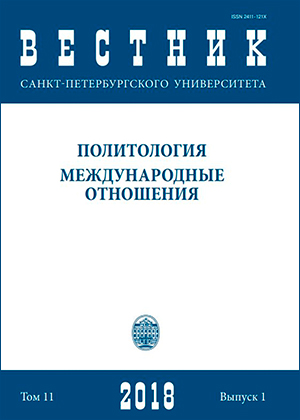“The law of Thermidor” in the political history of Russia
DOI:
https://doi.org/10.21638/11701/spbu06.2018.103Abstract
The article refers to the “Thermidor law”, characteristic of all great revolutions. The author states that after a period of radical destruction of the old foundations, a period of full or partial restoration of the previously destroyed orders, institutions and relations begins. This trend is called, by analogy with the events of the Great French Revolution, “the law of the Thermidor”. The article notes that after the October Revolution in Russia, Lenin and other leaders of the Bolsheviks constantly feared the offensive of the “Thermidor”, which they understood as the victory of the counter-revolution. To avoid this, the Bolsheviks strived to maximally radicalize their transformations, and after the failure of the policy of “war communism” they tried to implement “self-thermidorization” in the form of a New Economic Policy. However, the Bolsheviks failed to avoid a return wave. According to L. Trotsky, one of the leaders of the October Revolution, the “thermidor” was the establishment of the Stalinist regime. Trotsky saw signs of the Thermidor in the revival of a number of social principles destroyed during the revolutionary years. It is noted in the article that, with reference to the Stalin period, one can speak of an “imaginary thermidor”, since Stalin did not refuse the main goals of the October Revolution, but the emergence of the Stalinist regime, from the original revolutionary practice of the Bolsheviks, was the result of the action of the “Thermidor law”. The article states that the effect of the same law was manifested in the period of political and economic changes in the USSR and Russia in the late 20th and early 21st century.
Keywords:
revolution, the Thermidor law, Lenin, Trotsky, Kautsky, Stalin, perestroika
Downloads
References
Brinton C. The Anatomy of Revolution. New York: W.W.Norton & Co., 1938. 326 p.
Полякова Н.В. «Закон Термидора»: традиции и новации // Вестник СПбГУ.Сер. 6. Философия. Культурология. Политология. Право. Международные отношения. Вып. 3. 2014. С. 98–106.
Каутский К. Терроризм и коммунизм // Полис. Политические исследования. 1991. № 2. С. 146–154.
Бердяев Н.А. Истоки и смысл русского коммунизма. Париж, 1955. Репринтное воспроизведение издания «YMCA-PRESS» Париж. — Москва: Наука, 1990. 224 с.
Троцкий Л.Д. Термидор // Новое время. 1990. № 32. С. 40–43.
Trotsky L. The Revolution Betrayed. What is the Soviet Union and Where is it going? London: Faber and Faber, 1937. 312 p.
Hough J. How the Soviet Union is Governed. Cambridge, Mass.: Harvard University Press, 1979. 693 p.
Trotsky L. The Russian Revolution. New York: Anchor, 1959. 524 p.
Ленин В.И. Государство и революция // Ленин В.И. Полное собрание сочинений. 5-е изд. М.: Изд-во полит. лит-ры, 1969. Т. 33: Август — сентябрь 1917. С. 1–120.
Струве П.Б. Интеллигенция и революция // Вехи; Интеллигенция в России: сб. статей. 1909–1910 / сост. Н.Казакова. М.: Молодая гвардия, 1991. С. 136–152.
References
Brinton C. The Anatomy of Revolution. New York, W.W.Norton & Co., 1938. 326 p.
Poliakova N.V. «Zakon Termidora»: traditsii i novatsii [“The law of Thermidor”: traditions and innovations]. Vestnik St. Petersburg University. Series 6. Philosophy. Culturology. Political science. Right. International relations, issue 3, 2014, pp. 98–106. (In Russian)
Kautsky K. Terrorizm i kommunizm [Terrorism and Communism]. Polis. Politicheskie issledovaniia, 1991, no. 2, pp. 146–154. (In Russian)
Berdiaev N.A. Istoki i smysl russkogo kommunizma [The origins and meaning of Russian communism]. Moscow, Nauka Publ., 1990. 224 p. (Reprinted ed. of the publication: Berdiaev N.A.Istoki i smysl russkogo kommunizma. Paris, YMCA-PRESS, 1955). (In Russian)
Trotsky L.D. Termidor [Thermidor]. Novoe vremia, 1990, no. 32, pp. 40–43. (In Russian)
Trotsky L. The Revolution Betrayed. What is the Soviet Union and Where is it going? London, Faber and Faber, 1937. 312 p.
Hough J. How the Soviet Union is Governed. Cambridge, Mass., Harvard University Press, 1979. 693 p.
Trotsky L. The Russian Revolution. New York, Anchor, 1959. 524 p.
Lenin V.I. Gosudarstvo i revoliutsiia [State and Revolution]. Lenin V.I. Polnoe sobranie sochinenii [Collected Works] 5th ed. Vol. 33 (August — September 1917). Moscow, Izdatel’stvo politicheskoi literatury, 1969, pp. 1–120. (In Russian)
Struve P.B. Intelligentsiia i revoliutsiia [Intellectuals and revolution]. Vekhi; Intelligentsiia v Rossii: Sbornik statei. 1909–1910 [Milestones; Intellectuals in Russia: Collection of articles. 1909–1910]. Comp. by N.Kazakova. Moscow, Molodaia gvardiia, 1991, pp. 136–152. (In Russian)
Downloads
Published
How to Cite
Issue
Section
License
Articles of "Vestnik of Saint Petersburg University. International relations" are open access distributed under the terms of the License Agreement with Saint Petersburg State University, which permits to the authors unrestricted distribution and self-archiving free of charge.




